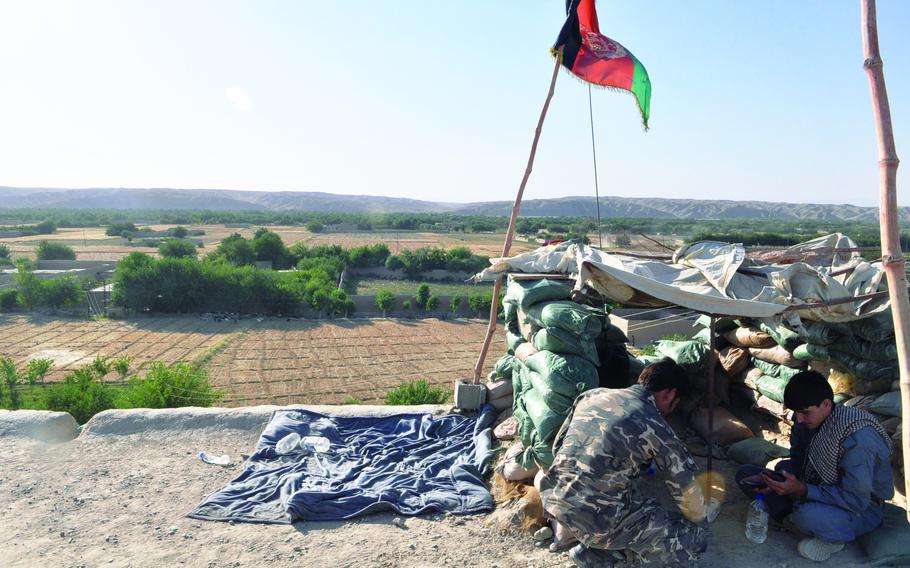
Afghan National Security Forces fighters stake out a roof overlooking Sangin District's "green zone." The green zone is where fighting for Sangin was most intense last week, since the vegetation offered insurgents cover and made it easy for them to hide IEDs. (Cid Standifer/Stars and Stripes)
SANGIN, Afghanistan — From the air, Sangin district looks like two planets merged: One a seemingly lifeless landscape, the other an earthly oasis of green pastures and orchards.
Fed by the Helmand River and an irrigation system left by the Soviets, the area called “The Green Zone” by Afghan government and U.S. troops, in recent weeks has been a haven for insurgents.
Retaining government control over this verdant pocket of farmland, wrested from the Taliban by British and U.S. forces at great cost, has proven a challenge as the insurgents test the capability of Afghan National Security Forces.
A recent battle showed that while the Afghan forces have the resolve, they, like their counterparts elsewhere in the country and NATO coalition forces over the last 12 years, have struggled to swiftly take and then hold ground in insurgent strongholds.
On May 19, Taliban forces swept into the area, taking over three ANSF checkpoints as government forces ran out of ammunition.
On May 28, the ANSF began a counteroffensive to force the Taliban out of the district, leading Maj. Gen. Lee Miller, commander of NATO troops in Southwest Afghanistan, the next day to applaud the Afghan government’s progress and predict imminent victory.
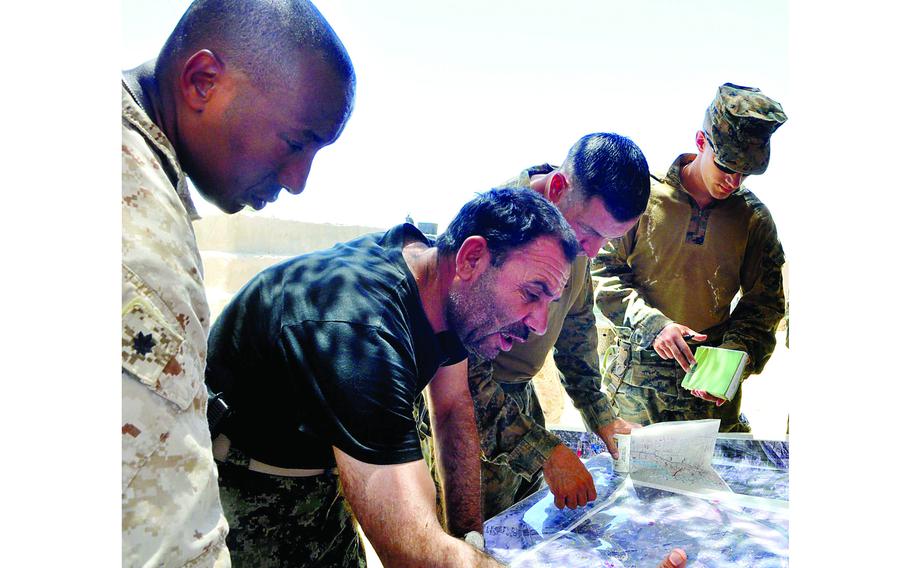
NATO coalition troops and an Afghan army officer, including, from left, security force advisory team leader Lt. Col. Jonathan Loney, 2nd Brigade, 215 Corps commander Brig. Gen. Abdul Wasea, and police advisory team leader Maj. Brian T. Mulvihill, examine a map of Sangin district, which has become a focus for both the Taliban and the Afghan government in recent weeks. (Cid Standifer/Stars and Stripes)
“I suspect by tomorrow the Taliban will have been defeated in Sangin and move out to wherever else they intend to go here in the future,” he told reporters May 29.
But that turned into a stack of tomorrows as the battle stretched out to a week.
The operation to take back the checkpoints and bring the district back under government control was hindered early on by logistical problems, which have long plagued ANSF troops here.
The three checkpoints ANSF were forced to temporarily abandon are in the Green Zone close to the Helmand River, which is surrounded by uneven terrain, meandering creeks and pockets of vegetation that hinder resupply, said 1st Lt. Dom Pellegrini with the Afghan National Army Adviser Team at Forward Operating Base Jackson.
Officials from both the government and the NATO-led International Security Assistance Force stressed that Kabul had supplied all the ammunition needed to the district. But moving supplies from bases and way points to the troops at the frontlines has proven more of a challenge.
Sangin police chief Ghulam Wali said his police — part of the multi-force Afghan team collaborating in Sangin — could have pushed the Taliban over the river and out of the Green Zone on May 29, if they had been able to resupply their forces more quickly, but they were forced to pull back as night fell.
On May 30, as they were attempting to defuse an improvised explosive device under a small bridge, it detonated, taking the bridge with it. That meant they would have to carry supplies in on their backs, which he said would likely slow them down by another day.
The Afghan army commander here, Brig. Gen. Abdul Wasea, said that obstacle was nothing they couldn’t handle.
“The troops have to find another way to cross,” he said. “That’s the troops’ job.”
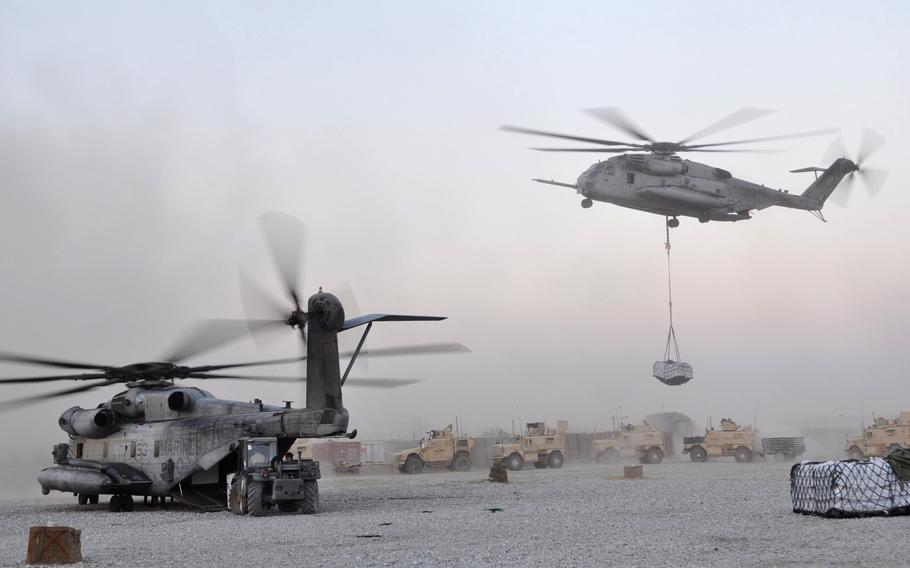
A UH-53 and UH-59 drop off supplies at Forward Operating Base Jackson in Sangin District. Sangin has become a symbol for the insurgency, the Afghan government and the NATO coalition alike, and in recent weeks has become the locus of intense fighting. (Cid Standifer/Stars and Stripes)
Meanwhile, government forces were being picked off by snipers and IEDs. On May 29th alone, Day 2 of the Afghan government’s counteroffensive, Wali said, he lost five police officers, three of them to IEDs. Another six were wounded. In the first two days of the operation, five Afghan soldiers were killed.
ANSF leaders placed the heart of their operations in a mud compound that Marines call Patrol Base Cuba next to the newly paved 611 road, one of ISAF’s biggest development projects in the region and an economic artery between Kajaki and the country’s main thoroughfare. One of the roofs in the compound offered a sweeping view of the Green Zone — when Taliban snipers weren’t taking potshots at the observers.
There, U.S. Marine Corps advisers and Afghan police and army officers bent over maps, while the boom of outgoing mortars jangled everyone’s nerves.
‘A lot of people have sacrified’
The U.S. has an emotional stake in the new battle for Sangin. The valley became famous in 2010 for claiming 25 American lives in the four months after the Marines took over from the British troops previously stationed there. Then, the IED threat was so severe that the commander of ISAF forces in Southwest Afghanistan sent tanks to the district. Sangin also took the son of Maj. Gen. John Kelly, then head of Marine Forces Reserve, making him the highest-ranking officer to lose a child in Afghanistan.
“A lot of people have sacrificed for this area, whether British, Marines or Afghans,” said American ANA Adviser Team member 1st Lt. Joe Falvey.
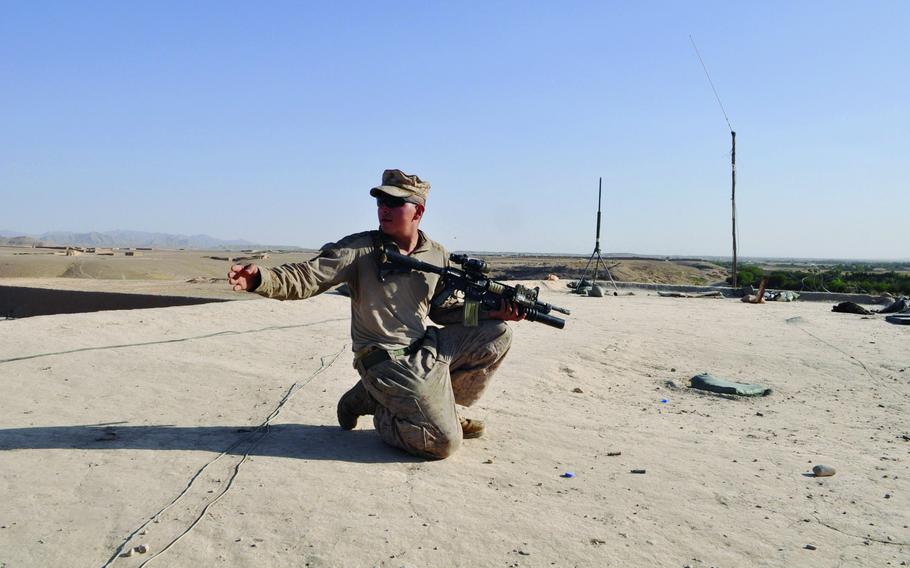
Lance Cpl. Miguel Delacruz sets up watch on top of a building at Patrol Base Cuba, the Afghan National Security Forces' home base during the fight for Sangin District. The valley has seen attacks ramp up as the Taliban has chosen to swing its assets there for a significant offensive. (Cid Standifer/Stars and Stripes)
For the Taliban, Wali, the police chief, says, Sangin has a similar visceral importance.
“This is their home,” he said. “These are the [Taliban] men’s houses.”
Local Taliban have enlisted help from other insurgents, some from a district or a province over, and some from as far away as Pakistan and Chechnya, Wali said. Police officers have overheard insurgents at the front speaking on their cell phones in Urdu, a language more common in Pakistan, and Wasea, the Afghan army commander, said villagers have found corpses of foreigners, though he did not say how villagers were able to tell.
By June 3, Afghan security forces had taken back all three of the checkpoints.
ISAF spokesman 1st Lt. Philip Kulczewski said that day: “Tomorrow is the final day of the offensive to secure all of the area in between ANSF posts. The Marines in Sangin are confident that ANSF will be successful.”
But Afghan and American officials acknowledged the Taliban likely never intended to hold the checkpoints, which would tie them to one position and rob them of their main advantage — mobility. Instead, in classic guerrilla fashion, the insurgents booby-trapped them and melted back into the landscape. While ANSF forces had managed to surround the empty checkpoints, they would still need explosive ordnance disposal teams to make them usable again.
Two weeks after ANSF’s counteroffensive began, Kulczewski said, Afghan government forces had completed a “sweep” of the district, but the operation was continuing as they maintained a “security blanket” around the area.
Wasea acknowledged that the fight in Sangin’s farmland would take time, since the vegetation makes it easy for the Taliban to hide both IEDs and themselves.
“We can’t have a soldier beside each tree,” he said.
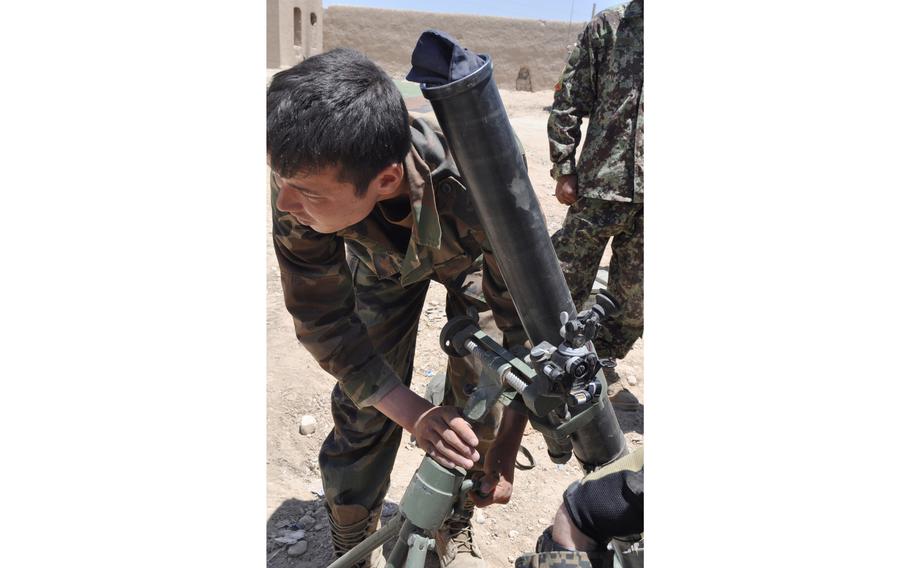
An Afghan National Army soldier works with a mortar launcher after Americans offer some additional training on aiming. The ANA fired mortars from Patrol Base Cuba, which is serving as a headquarters for the fight against the Taliban in Sangin District. (Cid Standifer/Stars and Stripes)